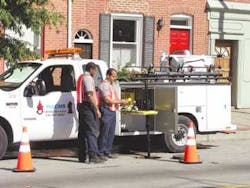By Cliff Wilson
Fifty years ago valve maintenance and exercising was not important. Water systems were young, clean and reliable. Today this has all changed. Water systems are aging, corroding; failing and utilities have to deal with more water quality testing, more construction, higher customer expectations, more pipe rehabilitation, new security concerns and GIS systems. It is a "catch 22". Fifty years ago water valves worked and we didn't need them, today they don't work and we truly need them — to operate, isolate and control the water system
The priority for valve maintenance — inspecting, exercising, documenting, mapping, repairing — is increasing in the industry. More and more utilities are beginning to understand the value of their valves and are taking action to stem the decline of operability. They are feeling the pain - both financially and operationally — of not being able to find valves. If they do find the valve, many times they are paved over, broken, the box is misaligned or full of debris, the vault is full of debris or the valve breaks or doesn't hold for a shutdown.
Up to 40% of the valves in some systems are not immediately operable and up to 9% of valves are found closed. Attempting to operate a system under these conditions is very, very difficult and results in significant customer interruption as well as financial loss.
Culture
Some utilities are successful in tackling valve maintenance internally, most are not. It is not that utilities are poor stewards of the system, it has to do with culture and competing urgent priorities. Utilities are experts at responding to main breaks, investigating customer complaints and fixing what is broken. All of these activities are urgent and require immediate attention. It is this culture of immediate response - shifting from one urgent need to another - than prevents many utilities from successfully executing consistent daily activities, even if that activity is important, like valve maintenance. There are many examples of utilities designing a valve maintenance program, some even get started, but very few follow through.
The reason? The valve maintenance assets (people, equipment and technology) get pulled off to respond to the day-to-day urgent needs. At the end of the year the utility looks back and no (or only a few) valves have been maintained. Therein lays the case for outsourcing valve maintenance.
Outsourcing Continuum
Outsourcing can be looked at as a continuum. Some utilities choose to outsource the entire system to a private company, others outsource non-core functions and some try to do it all.
As the industry copes with current challenges more and more utilities are focusing on their core business — serving customers, responding to emergencies, troubleshooting and planning their systems — and outsourcing non-core functions — maintenance, testing, rehabilitation and construction.
Case of Outsourcing Valve Maintenance
Valve maintenance is a classic case for outsourcing. It is a long term program (not just a project), it is important, it demands focused, dedicated resources, it is highly repetitive, it must be planned in advance, it requires special equipment and know-how (to do it right), it does not disrupt normal operations and it requires focused management. All of these factors run contrary to the culture of most utilities.
Valve maintenance is an activity that can be "carved" out of the business and executed more efficiently as a stand alone outsourced program. The combination of these factors; culture, efficiency, specialized equipment and know-how, dedicated resources and a program approach lends valve maintenance strongly toward the outsourcing end of the continuum.
Options
Utilities can take one of four options in outsourcing valve maintenance
• Consulting
• Construction
• Information
• Package
The consulting option is where a utility knows it has a problem and engages an engineering firm to study the problem and recommend alternatives. Most engineering firms are not familiar with valve maintenance and apply their general knowledge to the issue in order to arrive at recommendations. Consulting typically turns into a follow-on construction, information or package program.
The construction option is where a utility is focused on the valves in the field (not how the program can benefit other areas or the information that a program can provide), writes a specification and bids it out at lowest price. In this program there is very little know-how, experience or expertise applied to the program. Information is not collected and analyzed and results in effectively "two guys in a pickup truck" turning the valves they can find with hand turners and cheater bars.
The information option is where a utility is focused on the information about their system (and not increasing the operability of their valves). A typical information program will be bid out, a surveyor will survey the valve lids (that can be located) and no valve improvements result — effectively "two guys with GPS equipment" shooting locations of lids.
The package option, one which more utilities are pursuing, is where the utility focuses on the full value a valve maintenance program provides: the consulting value, valve operation improvement and the information and analysis. In a package program the utility gets the benefit of "consulting" (best practices from other utilities, proven approaches, proven processes), the benefit of "construction" (more valve operability improvement through the use of specialized equipment), "information" (databases, improved maps, links to GIS, analysis and information available for operators).
The "package" approach is clearly the most efficient and effective approach to make structural improvements to the overall utility. Consultants, construction companies and surveyors do not have all of the expertise, equipment, personnel and experience to do all of the functions required. There are companies in the industry which focus on just this approach; providing total valve maintenance services which include all of the important functions. For example, Wachs Utility Services provides these programs to cities such as Baltimore, Charlotte and many others. This breadth of experience and knowledge allows the company to apply best practices with every utility and tailor programs to meet the needs of an individual utility.
Conclusion
Valves were operable when you didn't need them fifty years ago. Valves are not operable when you need them today. The financial and operational pain is becoming so great that the priority of valve maintenance is increasing in the industry. The culture of most utilities does not allow for the efficient execution of programs such as valve maintenance. More and more utilities are addressing this issue and deciding that valve maintenance is performed most efficiently and effectively by an outsourcing expert.
About the Author
Cliff Wilson is Chief Operating Officer of Wachs Utility Services. He may be contacted at [email protected].




